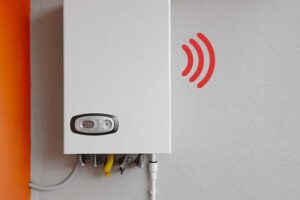Although balancing radiators may seem technical, it is quite simple when understood. Balancing your radiators ensures that each one receives the right amount of heat from your central heating system.
This means every radiator gets enough warmth, preventing one from getting too much while others receive less or none at all. It seems complicated but don’t worry; we shall simplify it for you.
How Does the Central Heating System Work?
It is important to know how your heating system works before you can start balancing your radiators. Imagine this: the heart of the central heating system is a boiler, which releases warmed air into a home through pipes.
In two directions, the heat from the boiler is sent out. First, it heats the hot water tank for bathing or washing dishes. Second, it warms rooms through radiators, keeping us cosy even when there’s snow on the roof.
In the majority of residences, generally each space accommodates a radiator that is linked in a loop with the boiler such that heat is cycled back. The dilemma is that heat does not always distribute evenly throughout all rooms.
For example, rooms near the boiler, like upstairs, often get more heat, while others stay colder. By balancing your radiators, you ensure every room receives the right amount of warmth.
Why is Balancing Radiators Important?
It is a commonly accepted fact; we always know heat rises right? The same goes for heating & cooling systems including radiators too! For example, radiators closer to or above the central heating system often get hotter than those farther away. It can result in uneven temperatures in different rooms. Ideally, you want all areas of your home to be evenly warm, not just isolated corners.
Another key reason for this is that it addresses the problem of uneven heat. This means there are cases when one radiator does not heat anymore even when the boiler is at full blast. The radiator is located at a distance from the boiler.
Therefore in cases like these, it does not distribute heat uniformly across the house. To ensure comfortable airflow throughout your home, regulating all radiators helps balance the warmth in each room.
Adjusting each radiator’s lockshield valve controls how much heat they produce during balancing. This directs more heat to the radiators that need it most. Although it seems difficult, with proper instructions, it’s quite easy to do.
To Bleed or Balance?

If you discover that your radiators are not functioning correctly, you have two options; bleeding or balancing them. Bleeding a radiator is ideal for you if it has cold spots or does not warm up completely.
This most often happens as a result of air pockets forming inside the radiator thus impeding proper heating from taking place. Therefore, if somebody bleeds the radiator, he or she allows hot water to flow freely through it and heat it up entirely.
Otherwise, if there are one or several radiators that do not heat at all even as the heat is turned on in the house, then you need to balance the ones that are hot. Balancing radiators makes sure the warmth is evenly shared in your house so that every radiator gets enough warmth.
Before getting into balancing radiators, it would be wise to start with bleeding them first. This helps in getting more precise temperature readings thus making the whole balancing thing work out better.
What You’ll Need
Balancing your radiators isn’t complicated, but you’ll need a few tools to get the job done. Here’s what you’ll need:
- A radiator bleeding key – this is used to release any trapped air from your radiators.
- A lockshield valve adjuster or an adjustable spanner – you’ll need this to turn the lockshield valve on your radiators.
- A screwdriver – some radiator valves might require a screwdriver to adjust.
- A digital thermometer – this will help you check the temperature of your radiators to ensure they’re balanced correctly.
How to Balance Radiators
Now that you’ve got your tools ready, it’s time to start balancing your radiators. Here’s a step-by-step guide to help you through the process:
- Get to Know Your Heating System: First things first, you need to get familiar with your heating system. When balancing radiators, you’ll need to start with the radiator closest to the boiler and work your way to the one furthest away. Understanding the layout of your system will make the process a lot easier.
- Turn Off the Heating: The next step is to turn off your heating and wait for the radiators to cool down completely. This is important because you’ll need to work out the order in which your radiators heat up once the heating is turned back on.
- Open the Valves: Once your radiators have cooled down, go around your home and open all the radiator valves by turning them anti-clockwise. If your radiators have thermostatic radiator valves, these can be easily turned by hand. However, for the lockshield valves, you’ll need to use the lockshield valve adjuster or an adjustable spanner.
- Turn the Heating Back On: After you’ve opened all the valves, turn the heating back on and take note of the order in which the radiators heat up. Usually, the radiators closest to the boiler will warm up first. It’s important to remember this order, as you’ll be balancing the radiators in this sequence.
- Turn the Heating Back Off: Once you’ve figured out the heating order, turn the heating off again and wait for the radiators to cool down. You want to make sure that they’re completely cool before you start balancing them.
- Turn the Heating On, Again: Now, with the heating back on, start the balancing process at the radiator closest to the boiler. This is where things start to get moving.
- Turn the Lockshield Valve to Balance the Radiator: Using your spanner or lockshield valve adjuster, turn it clockwise to completely shut off the lockshield valve on the radiator. Once it’s turned in all the way, turn it back slightly – about a quarter or half turn. This will let a little heat through, but not much at all. If necessary, you can further adjust the valve as the radiator gets hot enough. The main purpose of this is to manage that heat distribution from this radiator to its following counterpart in line. You are thus ensuring that even the next radiator receives just enough warmth by somewhat limiting its flow.
- Check the Temperature: To ensure proper heat distribution through a radiator, you need to check the temperature at both ends of the radiator. To take the temperature close to the lockshield valve, use a digital thermometer on your radiator pipework and then check again at the pipework near its corresponding thermostatic valve located on its other end. The goal is to maintain a difference of about twelve degrees between the two sides. If it’s not quite there yet, fine tune your readings by adjusting the lockshield valve slightly until you get it right.
- Continue This Process on Each Radiator: Once you have balanced the first radiator, proceed onto the second one in line and repeat this process again. Continue until all radiators in your house are balanced. Though it may take some time, finally you will have an ideally balanced heating system where every room in your house will receive just enough warmth.
The Bottom Line
Although balancing your radiators may seem like a little bit of trouble, yet it’s worth every ounce of sweat you shed. When there is uniformity in heat distribution around your house, not only do you feel at ease but it also makes it possible for you to use the heating system efficiently. Eventually, this saves on energy bills as less work has to be done by the boiler in order to maintain warmth within the house.
Next time a radiator fails to heat properly or some rooms are much warmer, balancing might be needed. With basic knowledge and the right tools, you can easily achieve a cosy, warm home during winter.
Frequently Asked Questions
Yes, you’ll need a radiator key, spanner, screwdriver, and a digital thermometer.
Balancing radiators can take a few hours, depending on your home’s size.
Yes, with the right tools and steps, you can balance your radiators at home.
Yes, bleeding radiators first helps make the balancing process more accurate.
You should balance radiators every few years or if you notice uneven heating.
Yes, a balanced system works efficiently, potentially lowering your heating bills.
No, bleeding removes trapped air; balancing ensures even heat distribution.








